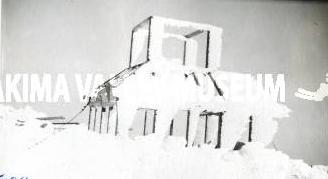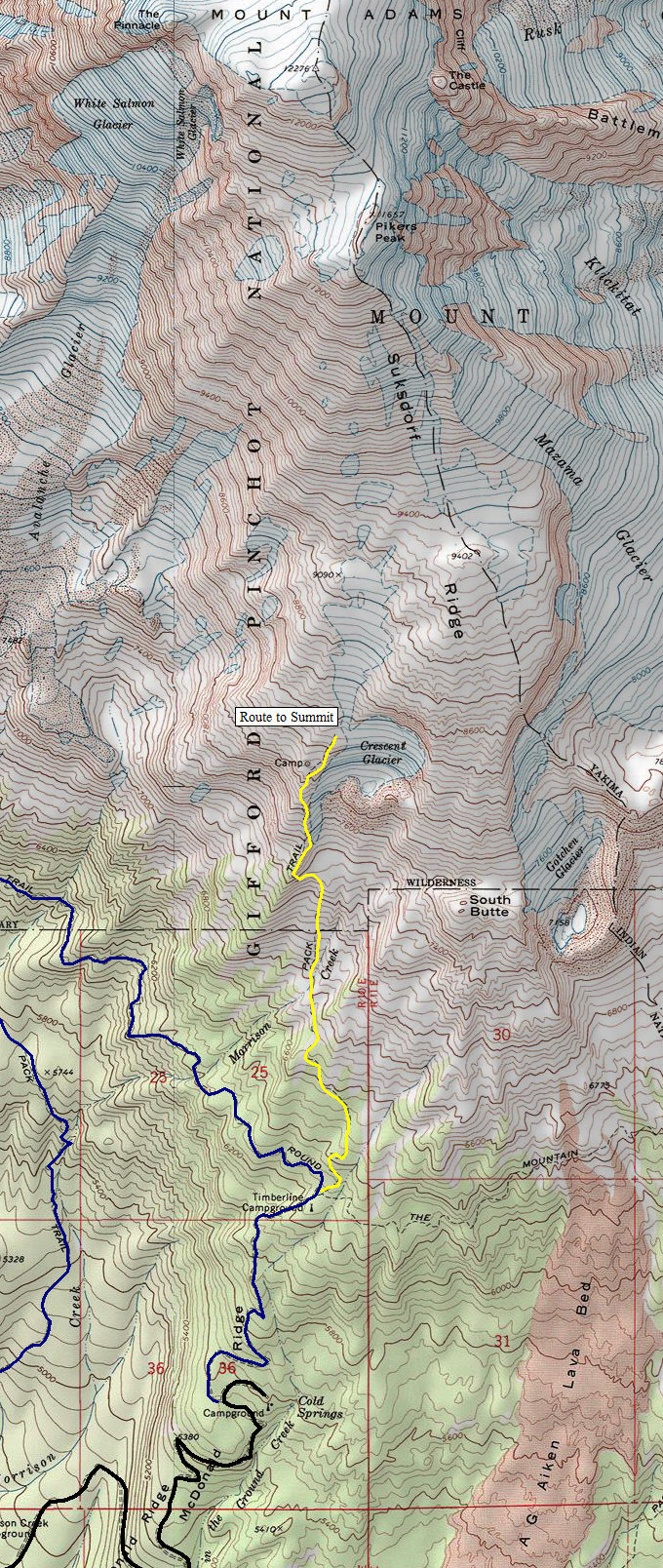
Mt. Adams
Mount St. Helens
Camping at the Lunch Counter
False summit from the Lunch Counter
Dozer on the summit getting some attention
On the summit, looking toward the building in distance
The true summit from the false summit at 11,657 (different trip than picture above)
The final hike up to the summit
Looking back at Pikers Peak (false summit)
The true summit from false summit area
Distance: 5.7 miles (South Spur)
Elevation Gain: 6,650 feet
Summit Elevation: 12,276 feet
Access: Gravel Road
Washingtons second tallest but largest mountain is Mt. Adams. Unlike Rainier, Adams South Spur climb is a good beginners climb with no real skills needed. Although I would recommend an ice ace and crampons, it is possible to climb to the summit in summer without them.
Coming from Hood River Oregon, cross over the Columbia River and go west. Turn north on SR-141, going north on the Mount Adams Recreation Road (SR -17). Branch off on to FR-80, FR-8040 and then FR-8040500 following signs for the "South Climb".
Coming from Randle (west of town), take highway 25 south over the bridge. A short distance beyond the bridge, Highway 23 branches to the left. Both turns should have large signs. Follow Highway 23 and signs toward Trout Lake. There will be a section of gravel road. Somewhere before Trout Lake is a sharp turn back north onto FR-80. Follow signs for the South Climb using FR-8040 and then FR-8040500.
The route starts with a nice trail up an old road to tree line. From there, a trail continues up to snowfields where you choose your own adventure. Most will follow the tracks of others, few ever get lost. The snowfields are not too steep; usually the snow is quite soft. At 9,000 feet is the lunch counter, a good campsite. From this point, you will be looking up to the false summit at 11,500 feet. In spring, the slope is fully snow covered but by late summer rocks protrude in places. I have even seen some in tennis shoes rock hopping the left side, but most prefer the snow. This area is also a 2,000 foot butt slide coming down. Usually several large trenches form from climbers doing this. Just before the false summit, you will hit the steepest part of the climb. I have used crampons here once in early spring. At the false summit, most put on another layer of clothing as the wind kicks up from the west. From there, it is an easy stroll on snow or trail over to the final 676 foot climb. A trail goes up this section in late summer. On top, there is an old 2 story building from the fire lookout days and when they mined sulfur from the crater. It is an airplane type view; you will be pointing out the big ones like Rainier, Hood, St. Helens and Jefferson. The climb is a long day trip or an enjoyable memorable overnight at the lunch counter. Camping at the trailhead campground also seems to help with acclimatization for 1 day climbs.
Route:
Access:
WillhiteWeb.com
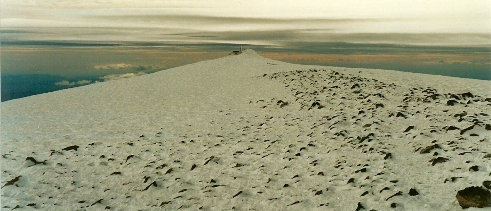
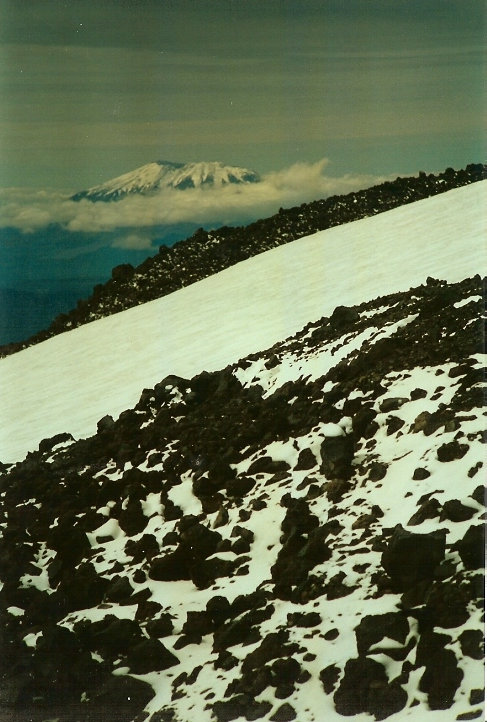
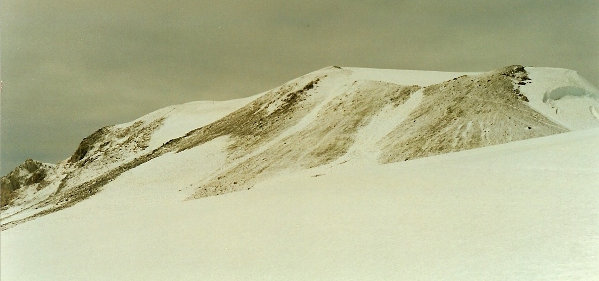
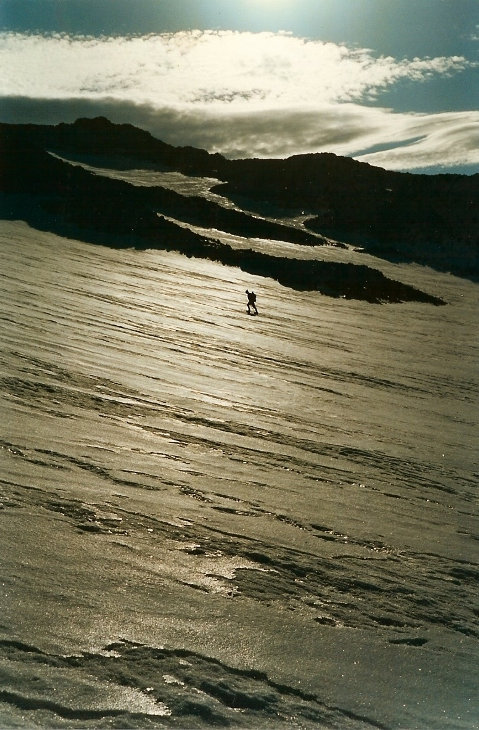
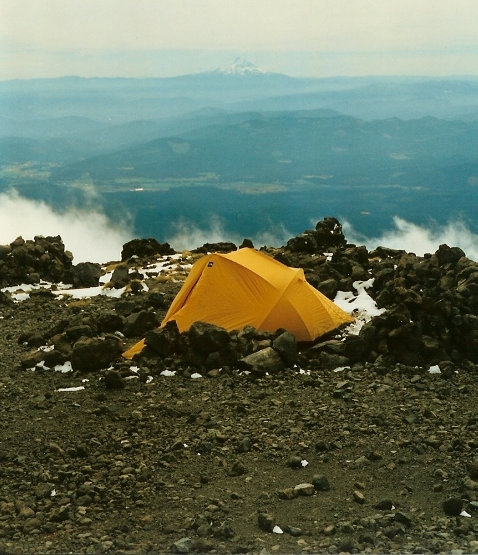
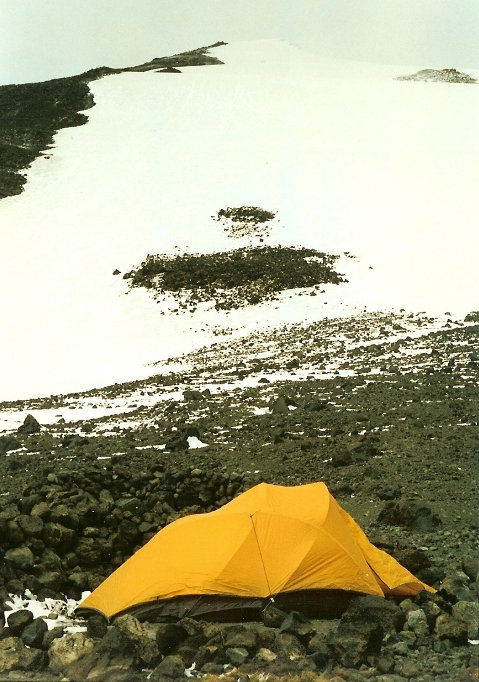
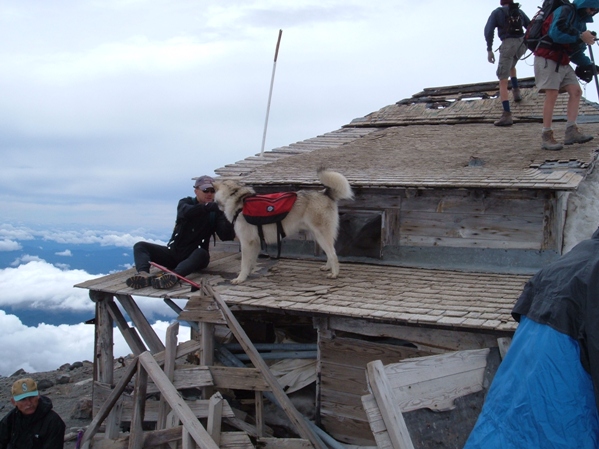
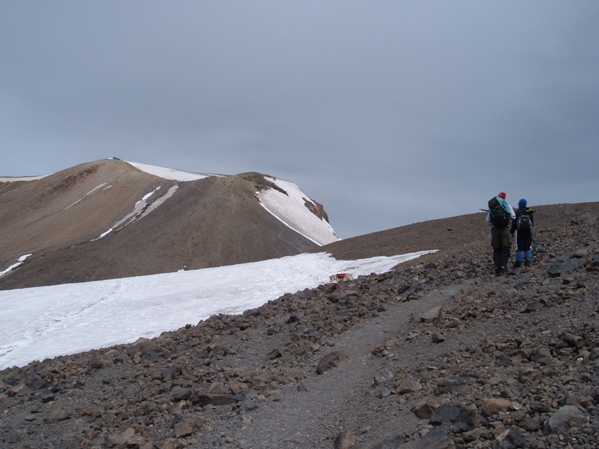
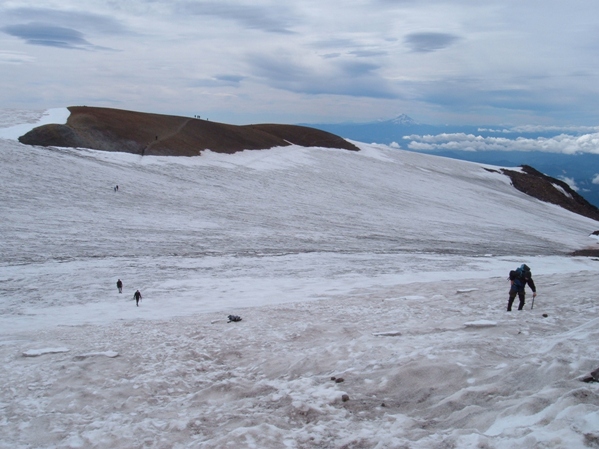
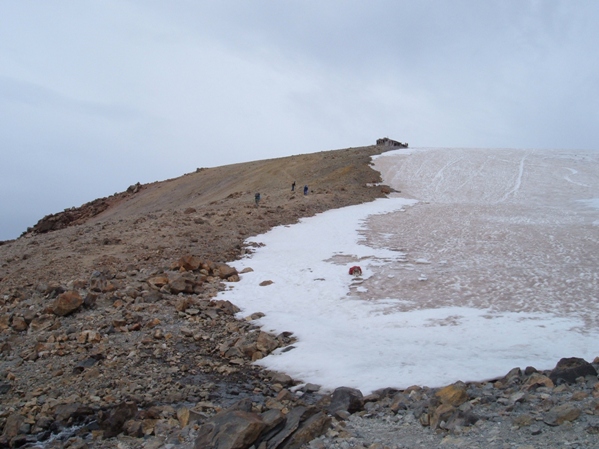
This lookout was the highest in the United States, and has a fascinating story as written below. Thanks to lookout enthusiast Ron Kemnow for finding all the news articles to piece the story together of the Mt. Adams lookout. The structure was a 12x12 foot wood frame D-6 cupola ground cabin with a second story cupola. It was not just the highest but one of the hardest to reach lookouts in the U.S. Read below how materials were packed up the mountain by mules, then hauled up by men to the summit using a special sled pulling technique. The structure was only in service from 1921 to 1924 as a fire lookout. In 1932, miners began extracting pure sulfur from the volcano's summit vent, and lived in the cabin. Two lean-to additions were tacked onto the original cabin for their use during the next decade. Today the summit building only becomes visible as the end of summer when enough ice melts off it. The inside is packed in ice, probably helping preserve the structure.
In September of 1916, officials were checking Mount Adams to ascertain the best location for a lookout on the summit of that peak. With those additional fire lookout stations it will be possible to control all Southern Washington and most of Western Oregon." (Morning Oregonian) "the feasibility of locating a forest lookout station on the summit of Mount Adams will be investigated by a party of forest officials who left district headquarters yesterday. The party consists of T,H, Sherrard, District Forest Supervisor; W.B. Osborne and W,L, Merritt, of the Portland headquarters, and T.H. Brundage, supervisor of the Columbia National Forest, the tract within which Mount Adams is situated. The peak will be scaled by all four of the officials, and, if possible, a desirable site selected for a station. (The Sunday Oregonian)
October 5, 1916: Forest Officers Merit, Brundage and Osborne returned last week from a trip to the summit of Mt. Adams, made for the purpose of selecting a site for a lookout station on that peak. Ranger Lickel and Mr. Fuhrer accompanied them. The trip was made from Portland by train to Guler, Wash. from Guler to snow line, a distance of 10 miles, the trip was made partly by machine and partly on foot. The party camped the first night at Cold Spring on McDonald Ridge. They left camp at 5 a.m. the second day, and arrived at the top of the mountain five and a half hours later, climbing from the south side. The main summit covers an area of about 160 acres of rolling country, half a mile west of the summit is a separate pinnacle about 150 feet lower in elevation which was also visited. From this point an excellent view is obtained of a large area of national forest land in Rainier and Columbia forests more than is visible from any other point. To the north could be seen Mt. Baker, near the northern boundary of the state, and to the south the Sisters Mts. mass in Oregon. This pinnacle was chosen as the site for a lookout station, on which will be built a standard lookout cabin. This cabin will be 12x12 feet, with a cupola or conning tower six feet square. Both main cabin and cupola will have a solid strip of window glass on all sides. A sub-station, equipped with telephone and fire finder, will probably be established on the main summit. Mt. Adams is 12,307 feet in elevation, or about 1,000 feet higher than Mt. Hood, where a successful lookout station has been maintained for the past two fire seasons. The party returned to timberline the same day, and the third day returned to Portland. An incident which occurred on the way down illustrates strikingly the efficiency of the fire lookouts on high mountains. When breaking camp at Bird Creek, on Bird Creek Meadows near timberline, the party piled the bows which had been used for bedding onto the fire, in order to clean up their camping place. For perhaps half an hour or less this caused considerable smoke, but it soon burned out. When the party arrived at Gotchen Creek Ranger Station they found a telephone message for Ranger Lickel informing hi, that a fire had been discovered near timberline on Mt. Adams. This fire has been sighted by Ranger Coalman, the lookout on Mt. Hood, 55 miles distant, and reported to the ranger station through the district office in Portland, the message reaching the ranger station an hour and a half after the fire started." (Gold Beach Reporter - Oregon)
After their ascent, "Supervisor Brundage, of the Columbia National forest, is spending several days at Guler. Mr. Brundage is making the final arrangements for conveying the material to the base of Mount Adams for the lookout cabin that the forest service contemplates erecting next Summer on the top of the mountain. The wagon road that leads to Morrison Valley, near the base, will be improved in places and will be continued up McDonalds Ridge to the Crescent Glacier, which is the highest point that may be made with horses. The plan is then to wait for snow and haul the lumber to the top on hand sleds. The forest service will also install a telephone on the mountain. (The Sunday Oregonian)
The following year in July and August, 1917, District Ranger Lickel had a large crew working to improve the road up the mountain. They also began hauling timber up the mountain to the 6000 foot elevation, then using an endless line to the top of the mountain. The line was strong telephone wire and was fastened on the top of the mountain. On each end of the wire was a sled. The sled at the bottom was loaded with lumber and the one at the top with stone. The stone-laden sled going down the mountain hauled up the lighter load of lumber.
Mr. Lickel also planned to build a cabin with bunkhouses, camp ovens and other conveniences for tourists and to fence a 10 acre meadow and also install a telephone in the Morrison Valley, at the base of the mountain, all for the free use of tourists.
By September 19, 1917: Chief Ranger Lickel, who is stationed at Guler, reports that the Forest Service now has the material for the lookout to be placed on top of Mount Adams, up two miles above the Crescent Glacier and at an altitude of 10,000 feet. Ranger Claude E. Crum, who is the lookout, has been occupying a tent at this point for several weeks, but today pulled up stakes and came to Guler. The recent rains have minimized the danger of fires. A telephone has also been installed at the lookout and also extended along the west of the mountain to the summit of the Cascades, which is also the boundary between the Columbia and Rainier forests. (Morning Oregonian)
August 19, 1920: The forest service standard lookout house, which has been on the way up Mount Adams for three years, has finally reached the summit, D. Vincent Stroup of the forest service says. All the lumber has now been packed to the top, and it only remains to decide upon a location and then put the house together. Here the difficulties begin, says Stroup, for there is only solid, blue ice on the mountaintop. The Mount Hood lookout is solidly anchored upon bare rock, but there is no such a rock on Adams - only a glacier. If the house is set upon the glacier, the ice will be cold underneath the floor and any heat within the cabin will tend to melt it and cause a sinking of the house. Delay in getting the lookout up Mount Adams has been due to forest fires each summer, which have called the packers away from the mountain. (The Oregon Daily Journal)
October 10, 1921: Blinding snow storms have been a hindrance to the building of a U.S. Forest Service signal station at the top of Mount Adams, in the state of Washington.
This peak is 12,307 feet high. Four years ago material for building a station was lugged to the peak and the frame work erected. Then a snow storm finally drove the builders down the mountain sides and the station frame and all the material was buried in a huge drift. This summer it was discovered again and work was taken up. Then another drift came and work has now been postponed until next summer. The Forest Service has telephone wires already poled to the summit of the peak. When the shack is finished fire lookouts will be on duty to report outbreak of flames in the country that can be seen for miles around. Recently the Cascadian Mountain Climbing Club of Yakima made the trip to the peak and found the partly-finished station half buried in snow. (The Bridgeport Telegram - Connecticut) (Images on this page)
October 1922: The house on the top of Mt. Adams has been completed by Lookout Arthur Jones and Fireman Adolph Schmid. The boys didn't enjoy the August storm as much as the rest of us. Ice formed all over the lookout house and the wind blew so hard for four days that they could not go outside. They spent all this time basking in the heat of an oil cook stove. (Six Twenty-Six)
September 2, 1923: A severe earthquake shock at 7:45 Wednesday morning and lasting about one minute, on the top of Mount Adams was reported today by Arthur Jones, forest service lookout, who was stationed on the peak. Mr. Jones said the windows and dishes rattled, the lookout station was shaken and that guy wires tugged (broke). (The Oregon Statesman)
1925: The lookout was discontinued and abandoned.
Lookout History:
See bottom.
Lookout History:
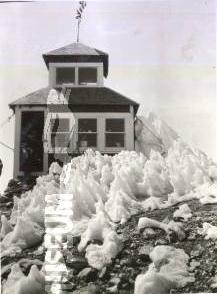
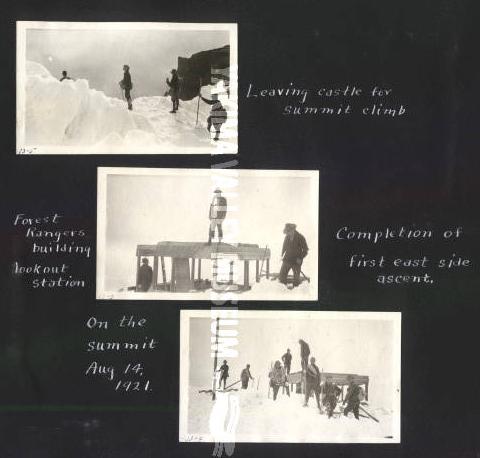
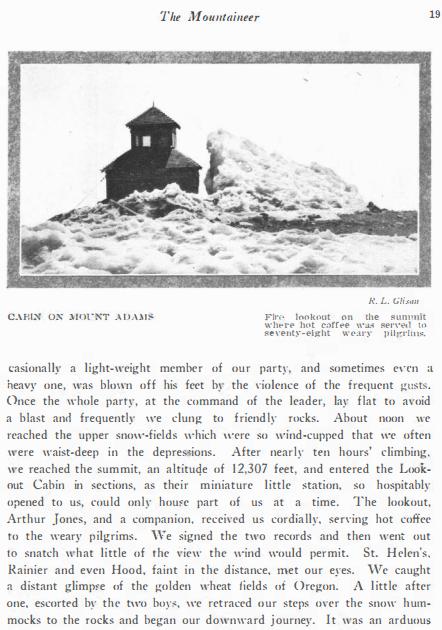


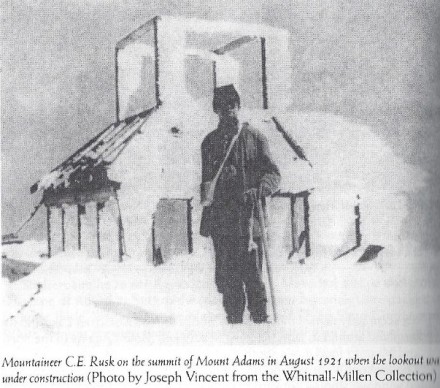
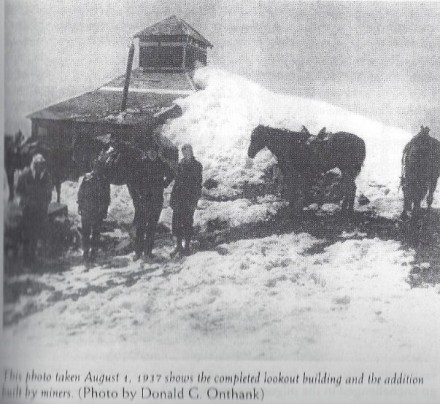
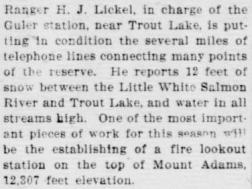
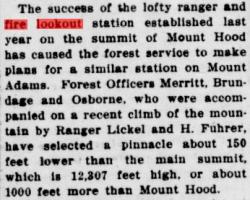
Mt. Adams cupola
Journal of the Mt. Adams 1921 climb by the Cascadian Mountain Climbing Club
From the Mountaineers Mt. Adams 1922 climb (78 climbers)
1921 under construction - iced up
Finished
Tacoma Times July 11, 1917
Lynden Tribune May 31, 1917
Lynden Tribune October 5, 1916
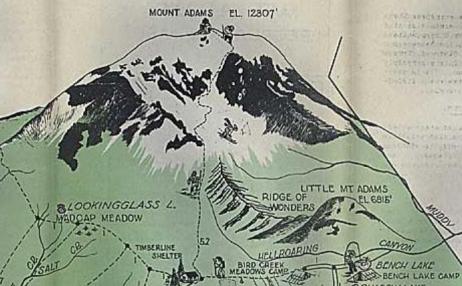
Mt. Adams recreation map 1936
